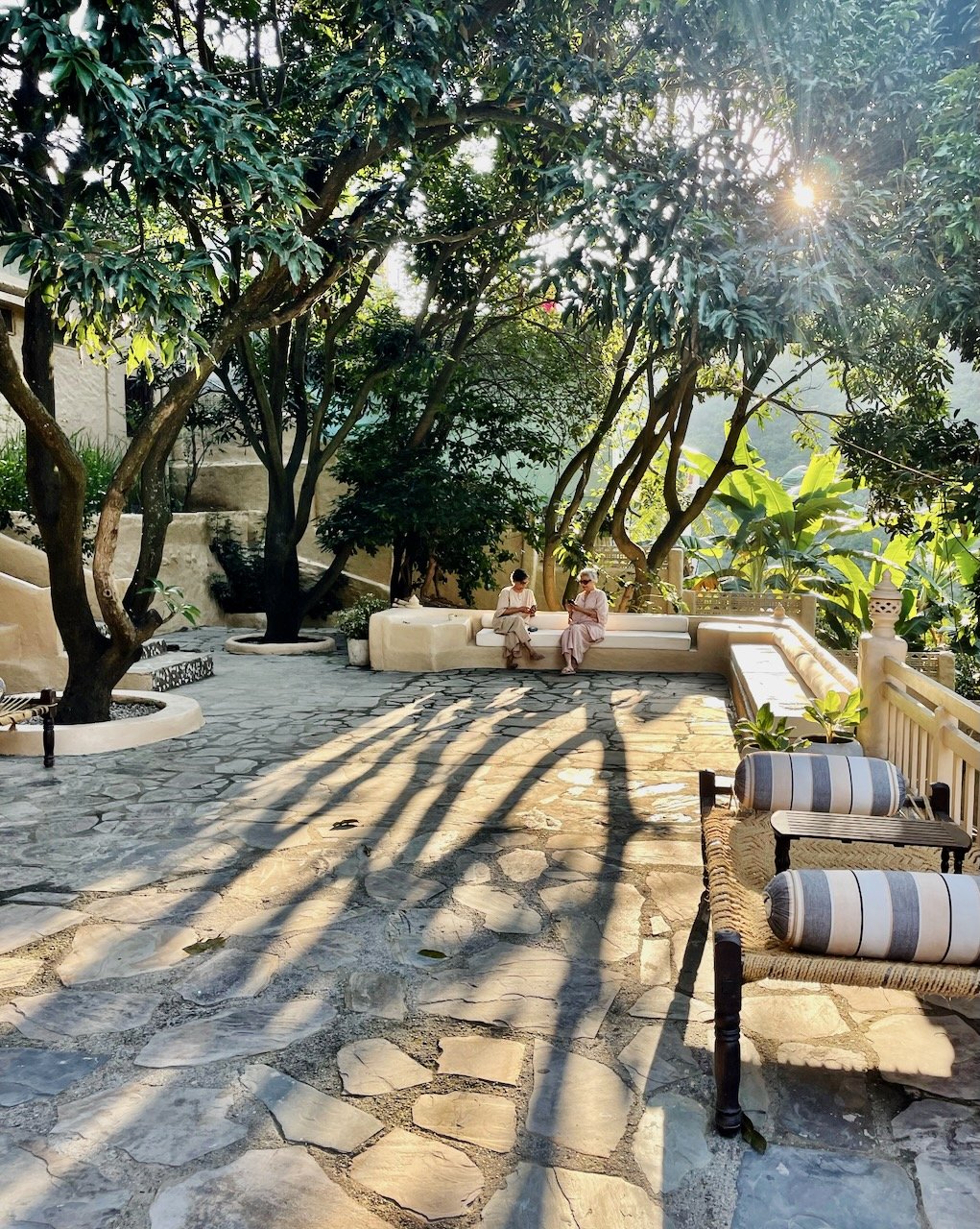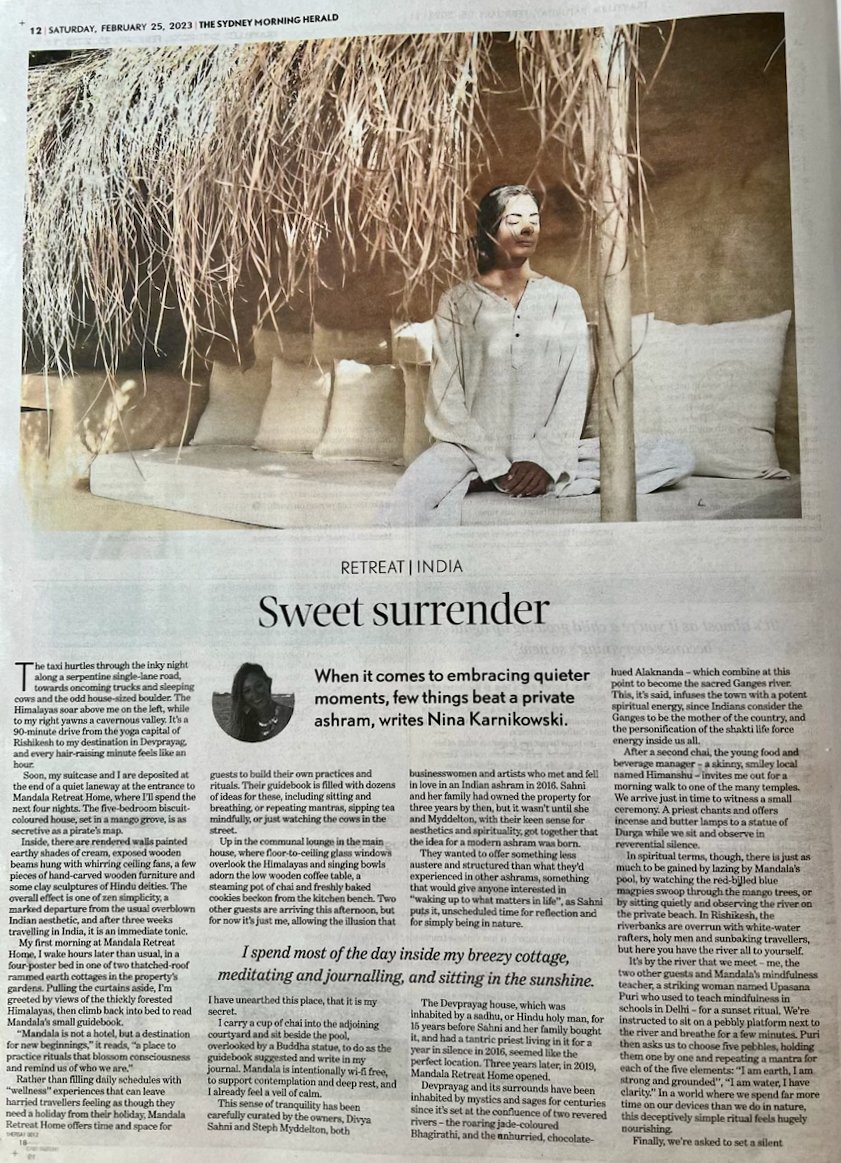SURRENDERING AT AN INDIAN ASHRAM: SMH TRAVELLER
WHEN IT COMES TO EMBRACING QUIETER MOMENTS, FEW THINGS BEAT A PRIVATE ASHRAM, WRITES NINA KARNIKOWSKI.The taxi hurtles through the inky night along a serpentine single-lane road, towards oncoming trucks and sleeping cows and the odd house-sized boulder. The Himalayas soar above me on the left, while to my right yawns a cavernous valley. It's a 90-minute drive from the yoga capital of Rishikesh to my destination in Devprayag, and every hair-raising minute feels like an hour.
Soon, though, my suitcase and I are deposited at the end of a quiet laneway at the entrance to Mandala Retreat Home, where I'll spend the next four nights. The five-bedroom biscuit-coloured house, set in a mango grove, is as secretive as a pirate's map.
Inside, there are rendered walls painted earthy shades of cream, exposed wooden beams hung with whirring ceiling fans, a few pieces of hand-carved wooden furniture and some clay sculptures of Hindu deities. The overall effect is one of zen simplicity, a marked departure from the usual overblown Indian aesthetic, and after three weeks travelling in India it is an immediate tonic.
Devprayag and its surrounds have been inhabited by mystics and sages for centuries. Photo: iStock
My first morning at Mandala Retreat Home I wake hours later than usual, in a four-poster bed in one of two thatched-roof rammed earth cottages in the property's gardens. Pulling the curtains aside, I'm greeted by views of the thickly forested Himalayas, then climb back into bed to read Mandala's small guidebook.
"Mandala is not a hotel, but a destination for new beginnings," it reads, "a place to practice rituals that blossom consciousness and remind us of who we are."
Rather than filling daily schedules with 'wellness' experiences that can leave harried travellers feeling as though they need a holiday from their holiday, Mandala Retreat Home offers time and space for guests to build their own practices and rituals. Their guidebook is filled with dozens of ideas for these, from sitting and breathing, or repeating mantras; to sipping tea mindfully, or just watching the cows in the street.
Up in the communal lounge in the main house, where floor to ceiling glass windows overlook the Himalayas and singing bowls adorn the low wooden coffee table, a steaming pot of chai and freshly baked cookies beckon from the kitchen bench. Two other guests are arriving this afternoon, but for now it's just me, allowing the illusion that I have unearthed this place, that it is my secret. I carry a cup of chai into the adjoining courtyard and sit beside the pool, overlooked by a Buddha statue, to do as the guidebook suggested and write in my journal. Mandala is intentionally Wi-Fi free, to support contemplation and deep rest, and I already feel a veil of calm being thrown over me.
This sense of tranquility has been carefully curated by the owners, Divya Sahni and Steph Myddelton, both businesswomen and artists who met and fell in love in an Indian ashram in 2016. Sahni and her family had already owned the property for three years by then, but it wasn't until she and Myddelton, with their keen sense for aesthetics and spirituality, got together, that the idea for a modern ashram was born.
They wanted to offer something less austere and structured than what they'd experienced in other ashrams, something that would give anyone interested in "waking up to what matters in life", as Sahni puts it, unscheduled time for reflection and for simply being in nature. The Devprayag house, which was inhabited by a sadhu, or Hindu holy man, for 15 years before Sahni and her family bought it, and had a tantric priest living in it for a year in silence in 2016, seemed like the perfect location. Three years later, in 2019, Mandala Retreat Home opened.
Devprayag and its surrounds have been inhabited by mystics and sages for centuries, since it's set at the confluence of two revered rivers - the roaring jade-coloured Bhagirathi, and the unhurried, chocolate-hued Alaknanda - which combine at this point to become the sacred Ganges river. This, it's said, infuses the town with a potent spiritual energy, since Indians consider the Ganges to be the mother of the country, and the personification of the shakti life force energy inside us all.
After a second chai, the young food and beverage manager - a skinny, smiley local named Himanshu - invites me out for a morning walk to one of the many local temples. We arrive just in time to witness a small ceremony. A local priest chants and offers incense and butter lamps to a statue of Durga, while we sit and observe in reverential silence.
In spiritual terms, though, there is just as much to be gained by lazing by Mandala's pool, by watching the red-billed blue magpies swoop through the mango trees, or by sitting quietly and observing the river on the private beach. In Rishikesh the riverbanks are overrun with white-water rafters, holy men and sunbaking travellers, but here you have the river all to yourself.
It's by the river that we meet - me, the two other guests and Mandala's mindfulness teacher, a striking woman named Upasana Puri who used to teach mindfulness in schools in Delhi - for a sunset ritual. We're instructed to sit on a pebbly platform next to the river and breathe for a few minutes. Puri then asks us to choose five pebbles, holding them one by one and repeating a mantra for each of the five elements: "I am earth, I am strong and grounded", "I am water, I have clarity." In a world where we spend far more time on our devices than we do in nature, this deceptively simple ritual feels hugely nourishing.
Finally, we're asked to set a silent intention for the days ahead, and I immediately know what mine is. Surrender. Like many travellers to India, I've been letting the country's intensity get the better of me, and I know that letting go and allowing things to just be will help me make the most of the time I have left here.
Early next morning, I take the 15-minute walk to Devprayag town. The steep, narrow alleyways are lined with small shops selling tea, incense and prayer beads, as well as rogue bicycles, stray dogs and cows. Candy-coloured houses and ancient temples cling to the sides of the mountains, and below them Hindu pilgrims and sadhus gather on the banks of the sacred confluence. Hindus believe the Ganges is able to purify all manner of sins, and facilitate liberation from an eternal cycle of life and death. Everyone is madly dunking themselves in the holy water, a psychedelic swirl of jade and brown as the two rivers merge.
"Tune in", reads one of the directives from the Mandala guidebook. "We have been habitually trained away from the practice of noticing the energetics of the external environment. Learn to follow your feelings in relationship to space." I take it as a permission slip, and when I return to the house I spend most of the day inside my breezy cottage, meditating and journalling, and sitting in the sunshine by the river. Letting go of the 'shoulds' most of us have listed in our heads when travelling, and instead taking cues from the river and allowing everything to just flow.
There are many peaceful moments peppered through the rest of my time at Mandala. The communal ayurveda-inspired vegetarian lunches and dinners, where a succession of some of the best curries I've tasted in India are accompanied by conversations about spirituality and simplicity. The long guided sunrise walk to the local village of Kothi high in the mountains, where turmeric and sesame seeds, chilli and okra grow wild by the dirt pathways and life seems not to have changed for centuries. The Indian flute player who visits to give us a private concert, and the sound bowl healing session that leaves me so grounded I can't stand up for 30 minutes afterwards.
The most tranquil moments of all, though, are those spent sitting silently by the river, feeling like the last person on earth.
This story first appeared in print below, and online here.


